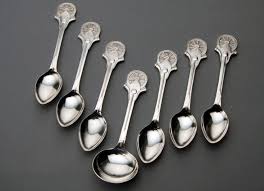Knowledge, Information and Experience
As a South Indian, Nikunj eat by hand. However, there is one distinct benefit in using spoon and fork, which actually helped me many times. Germs in hands. Yes, germs in hands can cause severe acidity problem. So if one eats by hand, it should be thoroughly washed with soap before eating. Otherwise, eating with spoon vs fork is helpful. Few western items are nice to eat with knife and fork only and is messy by eating by hand e.g. fish and chips in London or the traditional English Breakfast. Italian pasta is best eaten by fork. Chinese food tastes better through chopsticks or spoon and fork.
A spoon is a utensil consisting of a small shallow bowl (also known as a head), oval or round, at the end of a handle.
History: Preserved examples of various forms of spoons used by the ancient Egyptians include those composed of ivory, flint, slate and wood; many of them carved with religious symbols. During the Neolithic Ozieri civilization in Sardinia, ceramic ladles and spoons were already in use. In Shang Dynasty China, spoons were made of bone. Early bronze spoons in China were designed with a sharp point, and may have also been used as cutlery. The spoons of the Greeks and Romans were chiefly made of bronze and silver and the handle usually takes the form of a spike or pointed stem. There are many examples in the British Museum from which the forms of the various types can be ascertained, the chief points of difference being found in the junction of the bowl with the handle.
Language and culture: Spoons can also be used as a musical instrument.
To spoon-feed oneself or another can simply mean to feed by means of a spoon. Metaphorically, however, it often means to present something to a person or group so thoroughly or wholeheartedly as to preclude the need of independent thought, initiative or self-reliance on the part of the recipient; or to present information in a slanted version, with the intent to preclude questioning or revision. Someone who accepts passively what has been offered in this way is said to have been spoon-fed.
A spoonful—the amount of material a spoon contains or can contain—is used as a standard unit of measure for volume in cooking, where it normally signifies a teaspoonful. It is abbreviated coch or cochl, from Latin cochleare. “Teaspoonful” is often used in a similar way to describe the dosage for over the counter medicines. Dessert spoonful and tablespoonful may also be found in drink and food recipes. A teaspoon holds about 5 ml and a tablespoon about 15 ml.
The souvenir spoon generally exists solely as a decorative object commemorating an event, place, or special date.
Manufacture: For machine-made spoons, the basic shape is cut out from a sheet of sterling silver, nickel silver alloy or stainless steel.
Derivatives: Both the spork and the sporf are derived from the spoon: they combine the bowl of the spoon with the tines of the fork and with both tines and the cutting edge of the knife respectively.
Tags: Self Dependent










